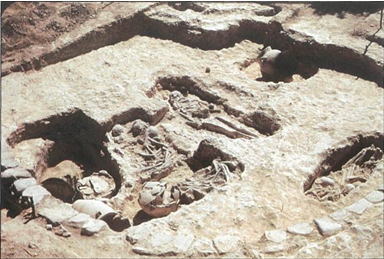Northeastern part of citadel
As mentioned above, the northeastern part of the hill¬top was apparently left open and unoccupied by buildings during the time the palace flourished (Fig. 2). Toward the northeastern edge, however, a complex of walls has been exposed, most of which belongs to Early Mycenaean times before the palace was built. What is left looks like a rela¬tively narrow street, lined on each side with house walls running from north to south. These walls seem to have survived because they lie in a slight hollow in the hilltop and were consequently not demolished when the northeast¬erly section of the hill was leveled off, perhaps in prepara¬tion for building the palace.
Farther to the north in the abrupt edge of the hill re¬mains of a gateway have been uncovered. The approach ascends steeply in a broad roadway paved with large stone slabs, laid almost in a step-like system. The gateway led through a circuit wall, scanty remains of which are still vi¬sible. Blegen traced the wall along the northwesterly scarp of the hill, but on the other side of the gateway to the south¬east and south no certain remains have yet been recognized. On the evidence of the pottery found, the gateway and the contiguous sections of the wall must be assigned to the beginning of the Early Mycenaean period, Late Helladic I.

This portal and the wall were apparently destroyed before the palace of Late Helladic IIIB was built.